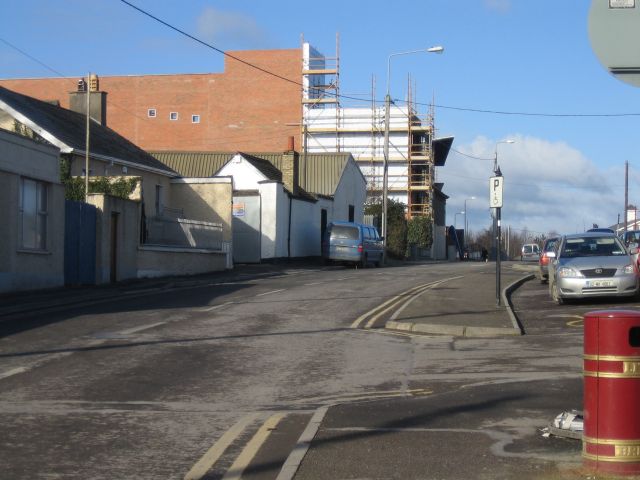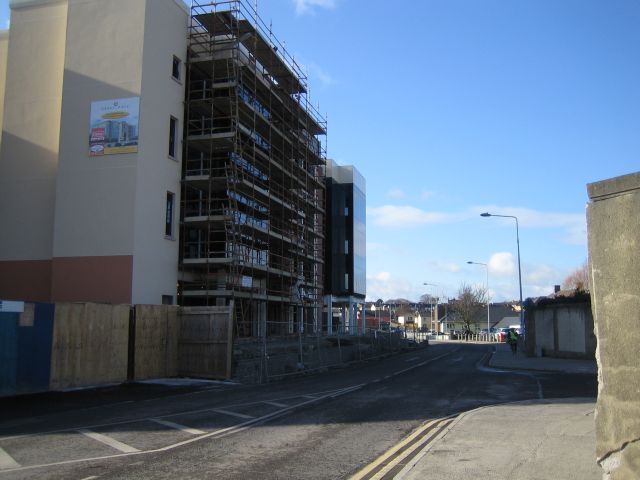Abbey Road
See also: Town Walls & Navan Town Wall
Abbey Road

Abbey Rd. gets its name from the old Abbey which was located close by.
The photo above shows Abbey Rd. (running left-right across the centre of the picture parallel to the River Blackwater) before the urban development from the 1980s changed its character completely - high density shops and offices associated with the new Shopping Centre, replacing the low density residential landuse that you see here. The Abbey would have been located where the cluster of buildings is found in the middle distance on the south side of the river. This site later was occupied by the Cavalry Barracks; from the early 20th cent. the old Abbey School operated here, and the final occupant was the Castle Clothing Company. Today its rubble is found behind walls which adjoin the carpark close to the Airport Bus Stop.
The row of cottages to the right of this is St Ultan's Tce. which replaced the older houses on Barrack Lane in the 1930s. The name Barrack Lane has disappeared from the streetscape of Navan, and Abbey Rd. now runs down to its junction with Watergate St. The fragment of the medieval Town Walls is found in this part of Abbey Road.


(above) The development of Abbey Rd photographed 2006 (Photos N&DHS)
The Medieval Town Walls are in the Co. Co. yard at the left of the photo.
*******
Recent Excavations on Abbey Road
http://www.excavations.ie/report/2002/Meath/0008815/
County: Meath Site name: Abbey Road, Navan
Excavations.ie number: 2002:1497 License number: 02E1456
Author: Ian Russell, ACS Ltd, Unit 21, Boyne Business Park, Greenhills, Drogheda, Co. Louth.
Site type: Town wall
ITM: E 687153m, N 768301m
Latitude, Longitude (decimal degrees): 53.657200, -6.681496
This excavation was conducted as part of a proposed strategy for mitigating the impact of a proposed development on archaeological remains at Abbey Road, Navan, Co. Meath. An initial assessment of the site conducted by Donald Murphy in 2000 (Excavations 2000, No. 766, 00E0767) revealed a number of possible archaeological features and a section of a possible robber trench along the suspected line of the town wall. A standing part of town wall, which contains a semicircular bastion, runs along the north-eastern corner of the site. After the submission of the planning application and the assessment report, Dúchas recommended refusal. At a subsequent meeting with Dúchas on 27 August 2002 (sought to clarify its views), it was requested that a strategy for mitigating the impact of the development on the known archaeology be submitted for consideration. This strategy was to include further excavation of the features identified during the initial assessment and a redesign of the development in the area of the town wall to reduce the visual impact of a proposed plant room
Only two ditches, both medieval, were exposed and excavated within the site. Early and late medieval pottery and animal bone were recovered from the fill. Both ditches appeared to be slightly curved and continued into the adjacent garden to the south-east. They were also observed in section at the shopping-centre carpark to the south. It is likely that both ditches functioned as a form of early medieval defence during the early stages of the development of Navan.
No trace of the robber trench was exposed during the excavation because of restrictions caused by the insertion of ESB ducting since the assessment in 2000, which prevented excavation in this area to the north of the site. It is not known what impact the insertion of this ducting has had on the possible robber trench, but it is likely that it will be exposed during any future groundworks. Consequently, it is recommended that pre-construction excavation of this feature should take place if permission is granted. It is highly unlikely that any part of the town wall survives below ground.
No demolition work is proposed for the post-medieval boundary walls near the medieval town wall. The proposed plant room will be moved further back from the town wall and will not have a negative visual impact on the town wall when viewed from the road level. It is proposed to pave the area surrounding the town wall.
http://www.excavations.ie/report/2000/Meath/0005589/
County: Meath Site name: ABBEY ROAD, NAVAN
Excavations.ie number: 2000:0764 License number: 00E0767
Author: Donald Murphy, Archaeological Consultancy Services Ltd, 15 Trinity Street, Drogheda, Co. Louth.
Site type: Urban medieval
ITM: E 686803m, N 768067m
Latitude, Longitude (decimal degrees): 53.655159, -6.686846
An archaeological assessment was carried out on a proposed commercial development at Abbey Road, Navan, Co. Meath, on 25 and 26 October 2000. The site lies just inside the north-west angle of the medieval town, and a stretch of town wall and bastion survives along the northern boundary of the site.
Eight trenches were excavated on the site. They indicated that quite an amount of disturbance had taken place during the 18th/19th centuries. The construction of a range of buildings in the eastern half of the site would have destroyed any deposits that may have been present. Over the western half of the site post-medieval quarrying of sand or gravel disturbed a large portion near the centre of the site.
Three ditches of possible archaeological significance were uncovered: two in Trench 1 close together, and the third in Trench 2. All three could be associated to some degree with the town defences. With the exception of the portion of the town wall along the north-east corner of the site, no other fragments were found either upstanding or buried. The ditches exposed may represent robber trenches for the wall where stone was taken for reuse elsewhere. None of the upstanding masonry on the site is of archaeological significance, and no medieval fabric survives even below ground. The natural sand and gravel were exposed almost directly below the modern ground surface, and the only real stratigraphy exposed was the garden soil in the western half of the site. Full archaeological excavation of the three exposed ditches will be required in advance of ground reduction.